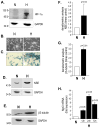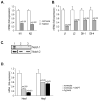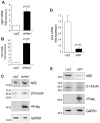Notch signaling modulates hypoxia-induced neuroendocrine differentiation of human prostate cancer cells
- PMID: 22172337
- PMCID: PMC3433043
- DOI: 10.1158/1541-7786.MCR-11-0296
Notch signaling modulates hypoxia-induced neuroendocrine differentiation of human prostate cancer cells
Abstract
Prostate carcinoma is among the most common causes of cancer-related death in men, representing 15% of all male malignancies in developed countries. Neuroendocrine differentiation (NED) has been associated with tumor progression, poor prognosis, and with the androgen-independent status. Currently, no successful therapy exists for advanced, castration-resistant disease. Because hypoxia has been linked to prostate cancer progression and unfavorable outcome, we sought to determine whether hypoxia would impact the degree of neuroendocrine differentiation of prostate cancer cells in vitro.
Results: Exposure of LNCaP cells to low oxygen tension induced a neuroendocrine phenotype, associated with an increased expression of the transcription factor neurogenin3 and neuroendocrine markers, such as neuron-specific enolase, chromogranin A, and β3-tubulin. Moreover, hypoxia triggered a significant decrease of Notch 1 and Notch 2 mRNA and protein expression, with subsequent downregulation of Notch-mediated signaling, as shown by reduced levels of the Notch target genes, Hes1 and Hey1. NED was promoted by attenuation of Hes1 transcription, as cells expressing a dominant-negative form of Hes1 displayed increased levels of neuroendocrine markers under normoxic conditions. Although hypoxia downregulated Notch 1 and Notch 2 mRNA transcription and receptor activation also in the androgen-independent cell lines, PC-3 and Du145, it did not change the extent of NED in these cultures, suggesting that androgen sensitivity may be required for transdifferentiation to occur.
Conclusions: Hypoxia induces NED of LNCaP cells in vitro, which seems to be driven by the inhibition of Notch signaling with subsequent downregulation of Hes1 transcription.
©2011 AACR.
Conflict of interest statement
The Authors have no conflict of interest to declare.
Figures




Similar articles
-
Differential Notch1 and Notch2 expression and frequent activation of Notch signaling in gastric cancers.Arch Pathol Lab Med. 2011 Apr;135(4):451-8. doi: 10.5858/2009-0665-OA.1. Arch Pathol Lab Med. 2011. PMID: 21466361
-
Inflammatory cytokines induce NOTCH signaling in nucleus pulposus cells: implications in intervertebral disc degeneration.J Biol Chem. 2013 Jun 7;288(23):16761-16774. doi: 10.1074/jbc.M112.446633. Epub 2013 Apr 15. J Biol Chem. 2013. PMID: 23589286 Free PMC article. Clinical Trial.
-
Prostate tumor OVerexpressed-1 (PTOV1) down-regulates HES1 and HEY1 notch targets genes and promotes prostate cancer progression.Mol Cancer. 2014 Mar 31;13:74. doi: 10.1186/1476-4598-13-74. Mol Cancer. 2014. PMID: 24684754 Free PMC article.
-
Hijacking HES1: how tumors co-opt the anti-differentiation strategies of quiescent cells.Trends Mol Med. 2010 Jan;16(1):17-26. doi: 10.1016/j.molmed.2009.11.001. Epub 2009 Dec 18. Trends Mol Med. 2010. PMID: 20022559 Free PMC article. Review.
-
Notch signaling in prostate cancer: a moving target.Prostate. 2014 Jun;74(9):933-45. doi: 10.1002/pros.22811. Epub 2014 Apr 16. Prostate. 2014. PMID: 24737393 Free PMC article. Review.
Cited by
-
βIII-Tubulin Gene Regulation in Health and Disease.Front Cell Dev Biol. 2022 Apr 28;10:851542. doi: 10.3389/fcell.2022.851542. eCollection 2022. Front Cell Dev Biol. 2022. PMID: 35573698 Free PMC article. Review.
-
ETV5 reduces androgen receptor expression and induces neural stem-like properties during neuroendocrine prostate cancer development.Proc Natl Acad Sci U S A. 2025 Mar 25;122(12):e2420313122. doi: 10.1073/pnas.2420313122. Epub 2025 Mar 21. Proc Natl Acad Sci U S A. 2025. PMID: 40117308
-
CXCR4-LASP1-G9a-SNAIL axis drives NEPC transdifferentiation via induction of EMT and downregulation of REST.Cell Genom. 2025 Aug 13;5(8):100916. doi: 10.1016/j.xgen.2025.100916. Epub 2025 Jun 10. Cell Genom. 2025. PMID: 40499539 Free PMC article.
-
Neuroendocrine Differentiation in Prostate Cancer: Emerging Biology, Models, and Therapies.Cold Spring Harb Perspect Med. 2019 Feb 1;9(2):a030593. doi: 10.1101/cshperspect.a030593. Cold Spring Harb Perspect Med. 2019. PMID: 29844220 Free PMC article. Review.
-
Notch signaling in prostate cancer: refining a therapeutic opportunity.Histol Histopathol. 2016 Feb;31(2):149-57. doi: 10.14670/HH-11-685. Epub 2015 Nov 2. Histol Histopathol. 2016. PMID: 26521657 Free PMC article. Review.
References
-
- Jemal A, Siegel R, Ward E, Hao Y, Xu J, Thun MJ. Cancer statistics, 2009. CA Cancer J Clin. 2009;59:225–49. - PubMed
-
- Grönberg H. Prostate cancer epidemiology. Lancet. 2003;361:859–64. - PubMed
-
- Jin RJ, Wang Y, Masumori N, Ishii K, Tsukamoto T, Shappell SB, et al. NE-10 neuroendocrine cancer promotes the LNCaP xenograft growth in castrated mice. Cancer Res. 2004;64:5489–95. - PubMed
-
- Li Y, Chen HQ, Chen MF, Liu HZ, Dai YQ, Lv H, et al. Neuroendocrine differentiation is involved in chemoresistance induced by EGF in prostate cancer cells. Life Science. 2009;84:822–7. - PubMed
-
- Abrahamsson PA. Neuroendocrine cells in tumour growth of the prostate. Endocr Relat Cancer. 1999;6:503–19. - PubMed
Publication types
MeSH terms
Substances
Grants and funding
LinkOut - more resources
Full Text Sources
Medical
Research Materials
Miscellaneous

